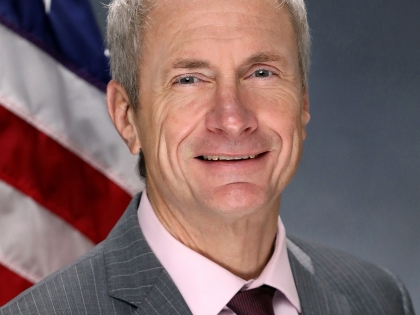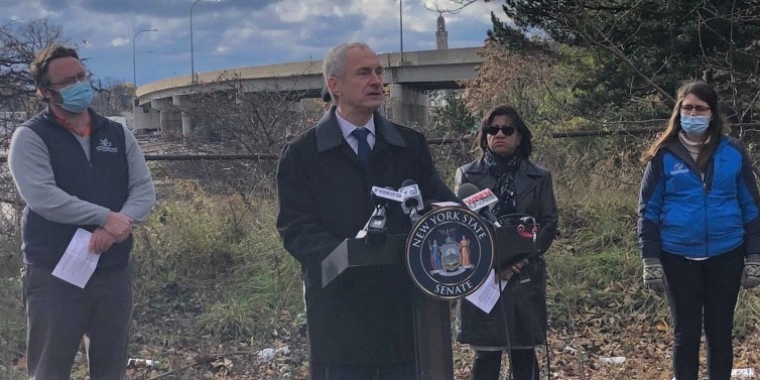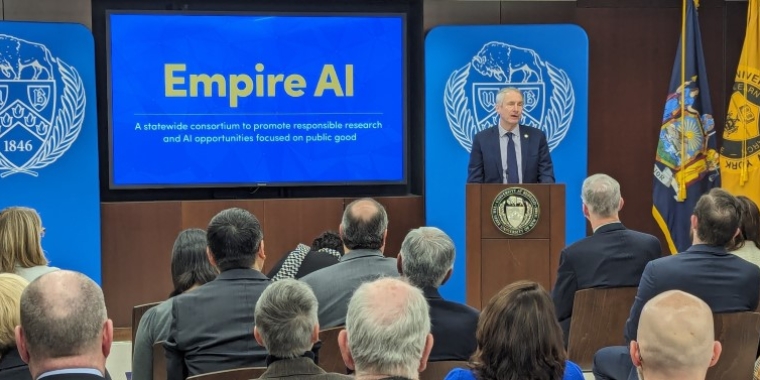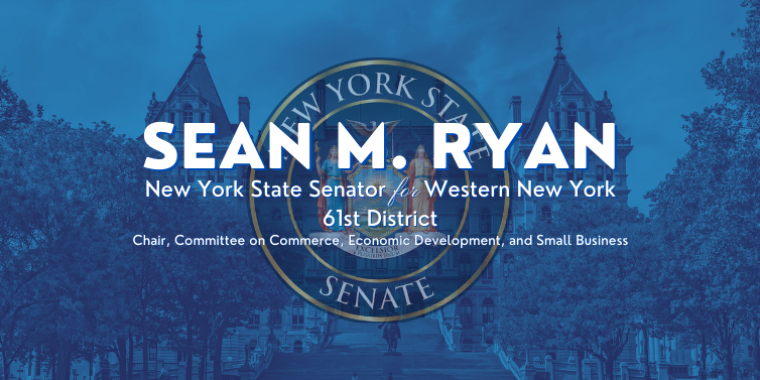
With Federal Infrastructure Dollars Coming To New York, Senator Sean Ryan Urges State DOT To Prioritize Key Buffalo Projects To Reconnect Neighborhoods
November 19, 2021
-
ISSUE:
- NYS Senator Sean Ryan
- NYS Senate District 60
- highway infrastructure
- Department of Transportation

WITH FEDERAL INFRASTRUCTURE DOLLARS COMING TO NEW YORK, SENATOR SEAN RYAN URGES STATE DOT TO PRIORITIZE KEY BUFFALO PROJECTS TO RECONNECT NEIGHBORHOODS
$1 Billion Has Been Dedicated To Restoring Communities Divided By Highways Like The Scajaquada And Kensington Expressways
BUFFALO – Today, November 19, 2021, New York State Senator Sean Ryan gathered with community stakeholders to urge the New York State Department of Transportation to prioritize the Scajaquada and Kensington Expressway projects when making plans for transportation projects to be funded by the recently signed federal infrastructure bill.
The federal Department of Transportation will be sending billions of dollars directly to states, which have wide latitude in determining which projects to fund. New York State will be directly receiving $11.6 billion of new highway funding, and will be eligible to apply for more than $211 billion in available discretionary grants that require approval from the federal Department of Transportation. In addition, $7.5 billion of new funding is available from the Rebuilding American Infrastructure with Sustainability and Equity (RAISE) grant program. A further $1 billion will be allocated to projects that reconnect neighborhoods that have been divided by the construction of highways. All of these funding streams provide a historic opportunity to fund the Scajaquada and Kensington projects, and reunite Delaware Park and the Buffalo neighborhoods that were divided by highways decades ago.
In a letter to the New York State Department of Transportation, Senator Ryan explained that Buffalo is a natural fit to receive federal funding, including from the newly created “Reconnecting Communities” program. Included in the infrastructure bill, the program reserves funds specifically for projects that will help restore communities divided by the construction of highways. Buffalo had two such highways constructed in the 1950s and 1960s, when the Kensington and Scajaquada Expressways were built. The construction of these highways divided and isolated several predominantly Black neighborhoods on Buffalo’s East Side, and this disruption continues to impact these communities more than 50 years later.
Approximately $140 million has already been dedicated to the Scajaquada Corridor project. The Greater Buffalo Niagara Regional Transportation Council is nearing the end of its “Region Central” initiative, a project conceived to identify the best course of action for the future of the Scajaquada Corridor. The funds available through the Reconnecting Communities program provide an opportunity to extend the original scope of the Scajaquada Corridor project and transform the Scajaquada and Kensington Expressways in a way that reunites surrounding communities and restores the vision of Frederick Law Olmsted.
Senator Sean Ryan said, “We have known for years that building highways through Delaware Park and the East Side of Buffalo disrupted communities in a way that has caused lasting harm. The decision to run the Scajaquada and Kensington Expressways right through the heart of communities of color is a perfect example of the kind of situation the federal Reconnecting Communities program has been created to address. The program presents a rare opportunity to repair decades of damage done by these regrettable decisions. Reuniting neighborhoods that were divided by the highways is an important first step toward fixing these historic injustices and lifting up neighborhoods that have been neglected for far too long.”
Hal Morse, Executive Director, Greater Buffalo-Niagara Regional Transportation Council, said, “Through extensive public and stakeholder involvement, we are establishing a path forward to strengthen the communities of Region Central with appropriate investments in transportation infrastructure and mobility. Based on new approaches to planning for this part of our region, we are building consensus for innovative solutions to significantly improve transportation, build strength in our economy, and improve our environment, our institutions, and community cohesion.”
Brian Dold, Chair, Scajaquada Corridor Coalition, said, “The Scajaquada Corridor Coalition is excited to hear about the infrastructure bill passing. Both Route 198 and Route 33 remain atop the Congress for New Urbanism’s nationally ranked ‘Freeways without a Future’ list. These intrusions are a critical priority for remedy.
The SCC believes undoing the damage to Delaware Park, Humboldt Parkway and the Scajaquada Creek corridor is vitally important to rebuilding, reconnecting, and healing our divided Buffalo communities. These restorations, which will directly address the legacy of racial inequities in highway design, while improving community quality of life and restoring parkland, are precisely the types of projects that should be funded through this infrastructure bill.”
Bradley J. Bethel Jr., Research Associate, Restore Our Community Coalition, said, “We at ROCC give immense thanks to the Joseph Biden Administration for passing the infrastructure bill as the next critical step towards repairing the economic and environmental health of the city of Buffalo. That path continues with equitable, community-based planning that brings the Queen City’s forgotten neighborhoods up to par with the standards of excellence we set for the city as a whole.
Restoring Humboldt Parkway and reconfiguring Scajaquada are essential for correcting generations of regional disparity created by decades of misguided planning. Both revivals accompany their Olmstedian roots as One Road, which in turn will serve as major milestones toward ushering Buffalo into the 21st Century. We invite the New York State Department of Transportation to help pave the path to recovery for the Queen City by prioritizing federal funding for the symbiotic replenishment of Humboldt and Scajaquada.”
Ellen Harris-Harvey, President, Trinidad Neighborhood Association Block Club, said, “The Trinidad neighborhood and Hamlin Park Historic District were a combined neighborhood until the construction of the Scajaquada Expressway caused their separation. This neighborhood is a strong, vibrant, resilient, predominantly African American community where many of the residents have resided for multiple generations.
I believe Frederick Law Olmsted understood and considered the needs of the people when he designed the park areas in Buffalo. These spaces provide a more pleasant environment and give people the ability to thrive and create community in a metropolitan area. Now is the time to correct the mistakes of the past and allow for restoration, reconnection, innovation, and progress. And now is the time to begin healing our Buffalo communities, where many to this day still highlight a legacy of past decisions based in racial inequality and exclusion.”
A copy of the letter appears below:
November 19, 2021
Hon. Marie Therese Dominguez, Esq.
Commissioner
New York State Department of Transportation
50 Wolf Road
Albany, NY 12232
Dear Commissioner Dominguez:
With the recent passage of the federal infrastructure bill, New York is set to receive an influx of funding that will make possible a wide variety of projects that have previously been underfunded. I write today to urge the Department of Transportation to prioritize Buffalo when applying for discretionary grants and identifying projects worthy of investment using these new funds.
The many investments being made in our national infrastructure include increased transportation funding in a host of important areas, including $7.5 billion of new funding for the Rebuilding American Infrastructure with Sustainability and Equity (RAISE) grant program and $11.6 billion in new highway funding for New York State alone. With a further $211 billion available for discretionary grants and the establishment of the Reconnecting Communities program, the Department of Transportation has the ability help secure transformative funding for Western New York.
This Reconnecting Communities program was established to fund projects that reconnect neighborhoods that have been divided by the construction of highways. It was tailor-made for cities like Buffalo, where the construction of the Scajaquada and Kensington Expressways in the 1950s and 1960s separated Delaware Park and divided neighborhoods on the city’s East Side. The construction of these highways predominantly affected communities of color, which have continued to be negatively impacted by this disruption more than 50 years later. The damage done by these expressways was not limited to cleaving communities physically; they also created new patterns in how people travel, and those new patterns isolated neighborhoods in a way that has disrupted people’s lives.
We have long known that highways should never have been built through Delaware Park and the East Side of Buffalo. Now, with the federal government’s focus on racial equity in transportation spending, we have a rare opportunity to help fund the removal of these expressways and begin to correct this historic mistake. Doing so is a necessary first step to rebuilding the communities that they have torn apart.
Approximately $140 million has already been dedicated to the Scajaquada Corridor project. The Greater Buffalo Niagara Regional Transportation Council is nearing the end of its “Region Central” initiative, a project conceived to identify the best course of action for the future of the Scajaquada Corridor. The funds available through the Reconnecting Communities program provide an opportunity to extend the original scope of the Scajaquada Corridor project and transform the Scajaquada and Kensington Expressways in a way that reunites surrounding communities and restores the vision of Frederick Law Olmsted.
Now is the time to finally right the wrongs of the past and commit to improving the lives of Buffalonians for generations to come. We are at a critical moment, and our state government must meet it with a response befitting the rare opportunity we are presented with. Thank you for your attention to this important matter.
Sincerely,
Sean M. Ryan
New York State Senator, 60th District
###


